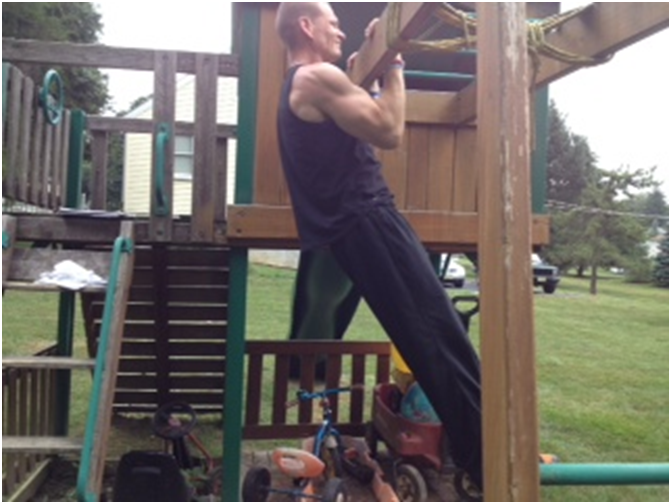A swing set is basically an outdoor gym for children. They run around it, climb on it, jump off of it and the best part about it is that they have a blast doing it. Well, adults should also get back on the swing set. We aren't going to be going down any slides or swinging, but we can turn the average swing set into an outdoor workout. The possibilities are endless so use your imagination on the swing set in your backyard or at the playground and hopefully you can build new workouts off of this program.
Your average backyard swing set, or park playground is a workout oasis. You can do pull-ups and chin-ups by hanging on the monkey bars or somewhere on the swing set. You can use it to perform inverted push-ups, feet elevated push-ups, planks, etc. You'll be able to find spots where you can do inverted rows and all other bodyweight exercises can be done right in the area of the swing set. You have the equipment, now you just need the program. This is where you can get most creative with your sets, reps, rest, and exercises.
I'm going to help those that are confined to the house because they have young children, for those who don't want to go to the gym, for those that want a restoration work out, and even those under house arrest. I woke this morning and decided to workout at home rather than make the trip to the gym. I setup a program that could be done outside on the swing set while the kids played right around me. Everybody was happy!!!
I love bodyweight exercises because they use relative strength. Relative strength is basically the strength that we have in relation to our own bodyweight. How many times you can push or pull your own body. Leaner/smaller individuals have much greater relative strength than those with bigger/ heavier body structures. However this can all be changed by simply performing bodyweight exercises in your programs. They are not only great for developing strength, but also teaching the body to work as 1 unit. Most importantly is that bodyweight exercises are safe. If you can lift your bodyweight you'll be able to perform the exercise, but if you can't, then you can't. When you can't do a specific exercise that you lack the strength for, you can simply regress them. I've included some regression exercises for the workout that I am giving you.
Get outside and get some exercise will ya! This is the program that you can try and complete in about 30 minutes or less, not including warm-up. I've included pictures of the exercises and also regressions for them. Give it a try, I know you will enjoy it! Of course, you will need to perform a proper warm-up before proceeding to the workout.
1) 50 Chin-ups/Neutral Grip Pull-ups
2) 100 Tricep Push-ups
3a) 50 Inverted Rows
3b) 100 Body Squats
4a) 100 Feet Elevated Push-ups
4b) 50/leg Bodyweight Reverse Lunges
This is a rep based workout whereas you must complete all of the reps for an exercise before you move onto the next one, unless you are supersetting (active rest). You'll notice 3a, 3b, 4a, 4b in the program. This simply means that you'll perform Body Squats while you are resting from doing inverted rows, and the same goes for 4a and 4b.
If you are a beginner you can simply cut the reps in half for each exercise and progress yourself up to the desired reps. Also, you may need to regress the exercise and do an easier form of it until you are able to eventually perform the full exercise for the desired reps. Your strength will come quick, especially if you are a beginner, so be patient....remember quality reps over the quantity of reps. You will get there, I promise. Your workout may look like this:
1) 50 or 25 Banded Chin-ups/Neutral Grip Pull-ups
2) 100 or 50 Inverted Tricep Pushups/Tricep Push-ups on knees
3a) 50 or 25 Knee Bent Inverted rows/or do T, Y, W's ( from another blog)
3b) 100 or 50 Body Squats
4a) 100 or 50 Inverted Push-ups/ Push-ups on Knees (see Push-up Blog)
4b) 50/leg or 25/leg Bodyweight Reverse Lunges
Exercises:
*Banded Chin-ups- I use a resistant band which will help with assistance, especially at the bottom of the movement where most help is needed for banded chin-ups. You can now buy these bands at Sport's Authority, Dick's or online. They can be used for many different exercises.
Chin Up
Neutral Grip Pull Up
Banded Chin Up

Banded Neutral Grip Pull Up
Tricep Push Up
Tricep Push Up on Knees
Inverted Tricep Push Up
Inverted Rows
Knees Bent Inverted Rows
Body Squats
Feet Elevated Push Ups
Push Ups on Knees
Inverted Push Ups
Body Weight Reverse Lunges















